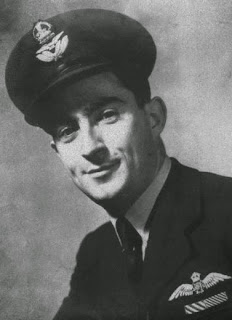No part of this material (unless credited to another source) may be reproduced, stored in a retrieval system, or transmitted, in any form or by any means, electronic, mechanical, photocopying, recording, or otherwise, without the written prior permission of the author. Some excerpts on this site are from the book, Immigrants of War.
Wednesday, July 23, 2014
(AUS.404692) Virgil (Paul) Brennan DFC, DFM - Course 26
Virgil (Paul) Brennan was born on 6 March 1920 at Warwick, Queensland, fifth child of Edgar James Brennan, solicitor, and his wife Katherine, née O'Sullivan, both Queenslanders. Educated at Christian Brothers' School, Warwick, Downlands College, Toowoomba, and Brisbane State High School, Paul became a law clerk in Brisbane and studied part time at the University of Queensland. After enlisting in the Citizen Air Force of the Royal Australian Air Force on 8 November 1940, he trained as a pilot in Australia and at No. 1 Service Flying Training School, Camp Borden, Ontario, Canada. Brennan graduated 12th in a class of 53. Squadron Leader Bradshaw assessed Brennan: "Well disciplined. Confident, aggressive and self-reliant." Squadron Leader Priestley remarked: "Has progressed steadily, learns quickly and has no outstanding faults." 'Digger' Brennan arrived in Britain in August 1941. Following operational training, he served briefly in the Royal Air Force's No.64 Squadron. He was promoted temporary flight sergeant on 4 January 1942 and next month was sent to the Mediterranean.
Posted to No.249 Squadron, on 7 March Brennan piloted one of fifteen Spitfires which flew from the aircraft-carrier, H.M.S. Eagle, to Malta. In mid-March the Germans began a major air assault on the island. Brennan and his comrades intercepted the waves of attacking bombers and their protective fighter screens: they had to contend with fatigue and inadequate rations while battling the enemy's superior forces. Proving himself a determined and courageous pilot, as well as an excellent shot, Brennan won his first victory ten days after his arrival when he destroyed a Messerschmitt 109. Further successes followed: on 20 April he shot down another Me-109; later in the day he dispatched a Junkers 88. Wounded in the left arm on 12 May, he was commissioned and awarded the Distinguished Flying Medal that month. By the time he left Malta in July, he had survived twenty-two combats, and been credited with the destruction of at least ten enemy aircraft and with damaging several more; a Distinguished Flying Cross was added to his previous award for gallantry.
On his return to England, Brennan and Pilot Officer Ray Hesselyn, a New Zealander from No.249 Squadron, collaborated with the journalist Henry Bateson in recording their experiences in Spitfires over Malta (London and Sydney, 1943).
Granted the rank of acting flight lieutenant and posted as an instructor to No.52 Operational Training Unit, Brennan was subsequently repatriated on 17 April 1943. Slightly built and 5 ft 9½ ins (177 cm) tall, he had dark hair and brown eyes. Although there was aggression in his manner, he had an easy-going nature, an engaging sense of humour and was loyal to his friends; his flair for oratory made him a forceful debater. On 1 May he joined No.79 Squadron, R.A.A.F. His commanding officer observed that he was strained and tired, and that he seemed to be marshalling his reserves for the unit's forthcoming deployment to Goodenough Island, off Papua. For all that, Brennan shared his operational experience with other pilots.
During their journey north, on 13 June 1943 the squadron's Spitfires reached Garbutt airfield, Townsville, Queensland. Brennan landed his aircraft in the stream of fighters, but the plane which should have landed behind him overran Brennan's machine and collided with it. Brennan died of his injuries on the way to hospital. He was buried with Catholic rites in Townsville war cemetery. (Sources: ADB, NAA)
Subscribe to:
Post Comments (Atom)


No comments:
Post a Comment